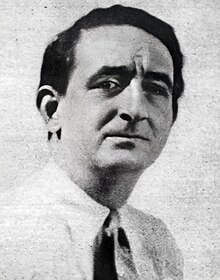Fulton Oursler | |
|---|---|
 | |
| Born | Charles Fulton Oursler January 22, 1893 Baltimore, Maryland, United States |
| Died | May 24, 1952 (aged 59) New York City, United States |
| Other names | Anthony Abbot (pen name), Fulton Oursler Sr. |
| Known for | The Greatest Story Ever Told (1949) |
| Spouses |
|
| Children | 4, including Will Oursler[1] |
Charles Fulton Oursler Sr. (January 22, 1893 – May 24, 1952) was an American journalist, playwright, editor and writer.[2] Writing as Anthony Abbot, he was an author of mysteries and detective fiction.[3] His son was the journalist and author Will Oursler (1913–1985).
Oursler was born and grew up in Baltimore, Maryland, the son of a poor city transit worker. His childhood passions were reading and stage magic. He was raised in a devout Baptist family, but at 15, he declared himself an agnostic. While still in his teens, he got a reporter's job for the Baltimore American.[4]
Oursler moved to New York City to edit The Music Trades. He freelanced for a variety of publications early on. His short stories appeared in The Black Cat, Detective Story Magazine, The Thrill Book, and especially Mystery Magazine. Many of his stories, such as "The Magician Detective", incorporate magicians and magic into the plots.[5]
In the 1920s, Oursler aided Harry Houdini in his crusade against fraudulent mediumship. He himself crusaded under the pseudonym Samri Frikell.[6] He was the author of the book Spirit Mediums Exposed (1930), which revealed the techniques of fraud mediums.[7]
John Mulholland wrote that Samri Frikell was the pen name of Oursler when he wrote on the subject of magic and spiritualism. He made it by combining the names of two magicians, Samri Baldwin and Wiljalba Frikell.[8]
He was supervising editor of the various magazines and newspapers published by Bernarr Macfadden, from 1921 to 1941. Macfadden urged him to drop the "Charles" from his name. He became editor of Liberty after Macfadden acquired it in 1931. In the fall of 1939, Fulton Oursler, as editor of Liberty, printed a piece in his magazine called "Alcoholics and God," which brought a rush of 800 frantic inquiries into the New York office of Alcoholics Anonymous, as it was to be known.[9]
Oursler left Macfadden Publications shortly after Macfadden was ousted from the company. Oursler's tenure with the company was continuous from 1921 to 1941, except for a brief period following the success of The Spider (1928).
In 1944, he became a senior editor for Reader's Digest (where his son eventually became managing editor).[10][11][12][13]
Oursler wrote a number of novels. These include Sandalwood (1925), Stepchild of the Moon (1926) and The World's Delight (1929). He also wrote detective stories and magazine articles under the pseudonym Anthony Abbot, as well as several plays, the most famous of which was the gimmick-filled The Spider (1928), co-written with Lowell Brentano and later filmed twice, in 1931 and 1945. The great success of the play attracted four plagiarism suits, which were successfully defended by Oursler's private attorney, Arthur Garfield Hays.
While still in his teens, Oursler married Rose Karger. They had two children. The marriage ended in divorce.[14]
In 1925, Oursler married Grace Perkins, who had been raised Catholic but lapsed in her teens. They had two children, April and Tony. They practiced no religion and did not raise their children in any faith.[14] Perkins, a former actress, was a prodigious contributor to the Macfadden magazines. Several of her novels were made into films.[15]
In 1935, the Oursler family toured the Middle East and spent a week in the Holy Land. On the journey home, Oursler started writing a book titled A Skeptic in the Holy Land. "I started out being very skeptical," he wrote later, "but in the last chapter I almost converted."[16] He assumed that once the book was published, he would forget about religion. However, perceiving the growing threat of Nazism and Communism, he found himself increasingly drawn to Christian ethics. Astounded at how little people knew about the life and teaching of Jesus Christ, he decided that he would write the story of Jesus and "try and make it as interesting as a serial story in a popular magazine." He would call it The Greatest Story Ever Told.[17]
In 1943, Oursler was received into the Catholic Church. The following year, his son converted to the Catholic faith, and his wife returned to her childhood faith a year later. His daughter converted in 1948. The Greatest Story Ever Told was published in 1949.[18] It was followed by The Greatest Book Ever Written in 1951, and The Greatest Faith Ever Known, completed by his daughter, April Oursler Armstrong, and posthumously published in 1953. The film, The Greatest Story Ever Told, based on Oursler's book, was released in 1965.[19]
Oursler also wrote, as Abbot, the Reader's Digest article that was made into the movie Boomerang! (1947). Another book was Father Flanagan of Boy's Town, 1949, the story of Fr Edward J. Flanagan's work with young men. The book was co-authored by Fulton's son Will, also a noted writer.[citation needed]

Oursler died in New York City in 1952, while halfway through writing his autobiography. Oursler left his estate to his second wife on the understanding that she would leave the estate to his four children. When she died, she only left it to the two children she had with Oursler and the other two successfully sued for their share.[1]